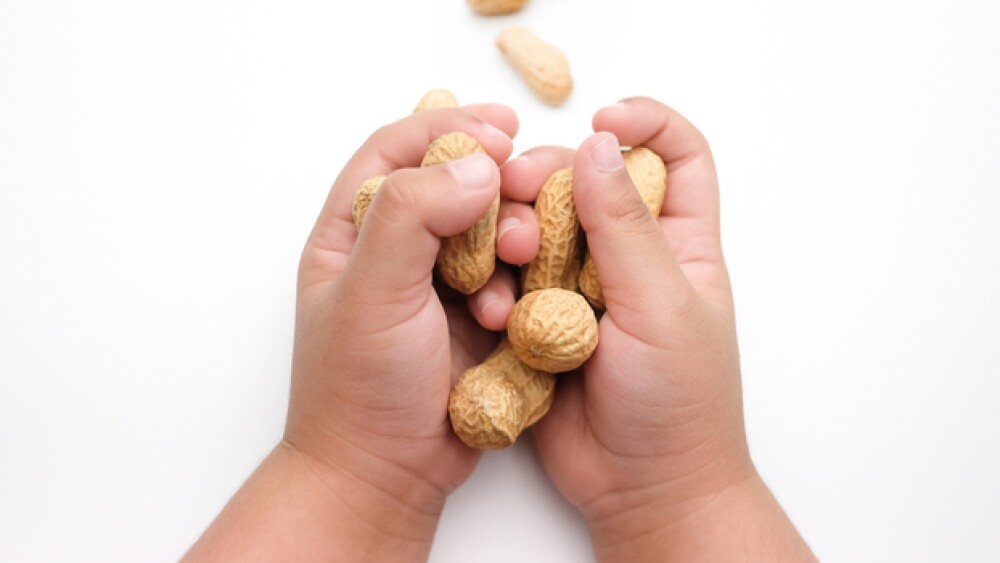It is estimated that 2.5 percent of all children in the U.S. might have a peanut allergy. Since 2010, according to the America College of Allergy, Asthma and Immunology, incidence of peanut allergies in children had risen 21 percent in the U.S.
Aimmune Therapeutics, headquartered in Brisbane, Calif., announced the publication of its successful Phase III PALISADE clinical trial of AR101 to desensitize patients with peanut allergies. The research was published in the New England Journal of Medicine (NEJM).
It is estimated that 2.5 percent of all children in the U.S. might have a peanut allergy. Since 2010, according to the America College of Allergy, Asthma and Immunology, the incidence of peanut allergies in children had risen 21 percent in the U.S.
At this time there are no approved drugs to prevent the allergy attacks. The rise in peanut allergies has resulted in schools banning peanut products, and a closer look at the processed food industry’s widespread use of peanut and peanut oil products in food.
For children with severe peanut allergies, accidental exposure, sometimes even airborne exposure, can be life-threatening. The only treatment is epinephrine to treat anaphylactic shock.
In Aimmune’s clinical trial, children ages 4 through 17 with peanut allergies were treated with AR101. AR101 is 12 percent defatted peanut flower using a Good Manufacturing Process (GMP). The participants were randomly split into three groups to receive AR101 or a placebo. Those who finished the regimen, which involved 300 mg per day of the maintenance regimen for about 24 weeks, then had a double-blind, placebo-controlled food challenge—they ate a challenge dose of something containing varying amounts of peanut protein.
A whole peanut kernel has 250 to 300 mg of peanut protein. About two-thirds of patients receiving AR101 tolerated a single dose of at least two peanuts, and about 85 percent tolerated the equivalent to about three to four peanuts. And about half of the AR101 patients tolerated the highest level, a single dose equal to three to four peanuts and a total of seven to eight peanuts total exposure.
“This publication in the New England Journal of Medicinerecognizes the rigor, scale and importance of the PALISADE trial, which will inform ongoing research in food allergy and could change practice for peanut allergy,” stated A. Wesley Burks, Executive Dean and Curnen Distinguished Professor of Pediatrics, University of North Carolina School of Medicine, and a member of the Aimmune Scientific Advisory Board. Burks was also senior author of the NEJM study.
Although AR101 has a favorable safety profile, there were adverse side effects in more than 95 percent of patients in both trial groups, although nearly all of them were mild or moderate in severity. However, 2.4 percent had severe adverse events and 1.1 percent experienced serious adverse events. Two patients required the use of epinephrine due to severe adverse events.
In addition, about 11.6 percent of patients dropped out of the study because of the side effects, compared to 2.4 percent in the placebo group.
In an independent review of the NEJM study, Michael Perkin, Senior Lecturer and pediatric allergy expert at St. Thomas’ Hospital and a Consultant Paediatric Allergist at St. George’s Hospital in the U.K., noted, “This is not something to start at home. Epinephrine was used by 14.0 percent of the participants in the active-drug group as a result of reactions to treatment. The longer-term side effects of sustained consumption of an allergen to which the body has produced IgE antibodies remain unknown. Current thinking has focused on eosinophilic diseases, such as eosinophilic esophagitis, but surveillance and follow-up would be crucial.”
Perkin also pointed out, “In reality, families are interested in how much peanut their child can be exposed to in one meal without it inducing symptoms, not the final dose. Furthermore, peanuts vary in size and therefore in protein content, so translating the doses of peanut protein that were used in the trial to the equivalent in actual peanuts is difficult.”
There are some allergists who are attempting something similar to AR101. For example, Whitney Molis, board certified in pediatrics and in allergy/immunology, at Pediatric and Adult Allergy in Des Moines, Iowa, uses oral immunotherapy (OIT) in an experimental setting. OIT, however, is not “standard practice” in all states.
Molis began using OIT in May 2011, only one of a small group of physicians in U.S., to use the treatment. “What we do is try to get small amounts of food into the patient’s body, and then build that up over time to create tolerance or a desensitized state,” she told KCCI Des Moines.
Molis claims to have a 100-percent success rate with her patients in creating a tolerance to peanuts. But she also warns that each patient is different, and some have to take the treatment slower than others, taking about six months.
In his evaluation of the Aimmune study, Perkin wrote, “The major concern regarding immunotherapy is that the allergen tolerance that is induced will be temporary and lost if regular consumption ceases. Neither the Cambridge group, nor the investigators in this trial, have attempted to establish the duration for which allergen tolerance is maintained in the absence of ongoing consumption.”
In the case of Molis’ patients, each patient is told to eat about 20 peanuts a day for the rest of their life to maintain their immune system’s tolerance to peanut proteins.
Apparently believing the Aimmune product will be a success—and likely require patients to take maintenance doses for the rest of their lives—Nestle Health Science increased its stake in Aimmune earlier this month with another $98 million investment. This gives Nestle a 19 percent ownership in Aimmune.
Aimmune expects to file with the U.S. Food and Drug Administration (FDA) in December. If approved, the therapy could be worth billions of dollars.





